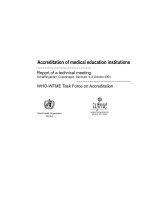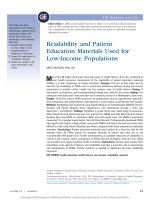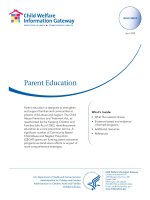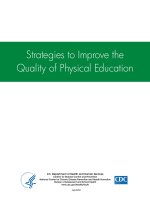BASIC CONCEPTS OF PATIENT EDUCATION potx
Bạn đang xem bản rút gọn của tài liệu. Xem và tải ngay bản đầy đủ của tài liệu tại đây (1.54 MB, 8 trang )
Section
I
BASIC CONCEPTS OF
PATIENT EDUCATION
Section I of this book, “Basic Concepts of Patient Education,” describes the importance
of teaching and learning in health care and physical and occupational therapy rehabilita-
tion as well as the historical development of patient teaching and learning. Section I con-
cludes by defining patient education within the context of rehabilitation and providing
an in-depth exploration of predictors that contribute to effective patient instruction.
Section I is divided into the following five chapters:
Chapter 1: Significance of Patient Education for Health Care and Rehabilitation
Chapter 2: Historical Outlook of Patient Education in American Health Care
Chapter 3: Historical Outlook of Patient Education in Physical and Occupational
Rehabilitation
Chapter 4: Patient Education in the Context of Physical and Occupational Reha-
bilitation
Chapter 5: Predictors of Effectual Patient Education
© Jones and Bartlett Publishers, LLC. NOT FOR SALE OR DISTRIBUTION
© Jones and Bartlett Publishers, LLC. NOT FOR SALE OR DISTRIBUTION
Objectives
After completing Chapter 1, the reader will be able to:
■ Identify the significance of patient education in health care.
■ Discuss the importance of patient education in physical and occupational
rehabilitation.
■ Compare and contrast the impact of patient education in health care and in
rehabilitation.
■ Understand the importance of patient education as related to health care and reha-
bilitation practices.
■ Identify the general significance and benefits of patient education and health
education.
The Significance of Patient Education in
Health Care
In contemporary health care, patient education is a patient’s right and a health care provider’s
responsibility. U.S. governmental efforts regarding health and patient education are illus-
trated in the Healthy People 2000 and Healthy People 2010 initiatives. These initiatives have
encouraged the United States as a whole to participate in health promotion and disease
1
SIGNIFICANCE OF PATIENT
EDUCATION FOR HEALTH CARE
AND REHABILITATION
© Jones and Bartlett Publishers, LLC. NOT FOR SALE OR DISTRIBUTION
Chapter 1 Significance of Patient Education for Health Care and Rehabilitation
4
prevention through exercising, appreciating better health and fitness, avoiding workplace
injuries, immunizing children against disease, and participating in preventive screening
programs. The upcoming Healthy People 2020 expands the goals for health promotion and
patient or client teaching and learning by incorporating specific health objectives for var-
ious races and ethnicities. It also includes a larger, contemporary definition of the concept
of health equality in relation to health risks caused by various genetic differences and pre-
dispositions to diseases or disorders.
PATIENT EDUCATION VERSUS HEALTH EDUCATION
Patient education is a significant component of modern health care.
1
Patient education
can be divided into two large categories—clinical patient education (or clinical teaching
and learning) and health education. Clinical patient education is a planned, systematic,
sequential, and logical process of teaching and learning provided to patients and clients
in all clinical settings.
2
It is also a continuous teaching and learning process involving the
health care provider and the patient or client (and/or the patient’s family). The goals of
clinical teaching and learning are based on the patient’s assessment, evaluation, diagno-
sis, prognosis, and individual needs and requirements related to interventions.
Health education is also a teaching and learning process similar to patient education.
However, it concentrates mostly on wellness, prevention, and health promotion. Addi-
tionally, health education can be provided to individuals, groups, and communities. The
basic focus of health education is to change and improve societal health behaviors. In regard
to both contemporary clinical patient education and health education, patients and clients
are taking a more informed and active role in health care–related decisions. This new
approach to health can be attributed to a variety of factors, including educational mate-
rials distributed by health care providers, the abundance of medical information found on
the Internet, and clinicians’ increased involvement in patient education. Furthermore, all
health care providers have been learning new risk assessment techniques in the context
of current health promotion and prevention. The illness-based thinking process has been
changing to a risk-based one that involves the patient as a collaborator and partner of care,
sharing responsibilities with the clinician.
1
The degree to which risky behaviors are reduced
depends mostly on the patient’s understanding of the significance of the risk and the impor-
tance of change. In this context, the primary role of the health care provider is that of
patient educator and supporter, to better help patients progress and effect the needed life
modification.
THE PATIENT-CENTERED CARE MODEL
Health professionals are increasingly encouraged to involve patients in treatment decisions,
recognizing patients as experts with a unique knowledge of their own health and their
preferences for treatments, health states, and outcomes. Increased patient involvement in
health care represents an important part of quality improvement of all health care organ-
izations.
3
Patients’ participation in health care assessments has been largely associated
with better health outcomes. As a result, health care providers need to expand their
patient-centered care practices. Modern health care has been evolving away from a disease-
© Jones and Bartlett Publishers, LLC. NOT FOR SALE OR DISTRIBUTION
centered model toward a patient-centered model. The patient-centered approach demon-
strates the highest quality of care, offering the most effective interventions, including edu-
cation, for an individual patient.
4
In addition, care that is truly patient-centered considers
patients’ cultural traditions, personal preferences and values, family situations, and
lifestyles. The patient and his or her family are an integral part of the health care team,
actively collaborating with health care providers in making clinical decisions.
4
Consequently,
patient clinical teaching and learning is essential in this context because it increases patients’
responsibility for important aspects of their self-care, monitoring, and continuum of care.
Patient-centered care also assures coordinated and efficient teaching and learning between
health care professionals and providers involved in each patient’s treatment.
4
THE BENEFITS OF PATIENT EDUCATION IN HEALTH CARE
Health care institutions are recognizing the benefits of patient education in improving
patients’ safety and adherence to interventions as well as patients’ satisfaction. In contem-
porary health delivery, patient education has the potential to counter the rise in health care
costs by reducing expenses and helping patients manage pricey chronic conditions. Adopt-
ing patient education programs can help health care providers and organizations produce
better outcomes and enhance quality of care. Effective educational materials can help
patients understand medical complexities while reducing anxiety and increasing compli-
ance with instructions. Patient educational resources have the ability to change commu-
nication into actions and improve health. Furthermore, in modern health care, patient
education is supported because it adds value to the management of various diseases and
disorders. Specific interventions aimed at increasing the patient’s knowledge can improve
the treatment outcomes of many acute and chronic illnesses. For example, when they
become ill, educated patients remain motivated and adherent with treatment programs.
1
Direct patient involvement in treatment decisions increases motivation, empowerment,
adherence, and satisfaction.
Patients should receive education and training specific and appropriate to the care,
treatment, and services provided. Patient education content should be personalized to each
patient depending on cultural differences and specific needs.
1
Patient education should also
be available in appropriate reading levels and be customizable to individuals. Successful
patient education is the result of comprehensive, proven solutions that are thoughtfully
set up by health care providers and integrated into the patient health care delivery system.
Additionally, an efficient patient education program can yield better quality of care in fis-
cally responsible health care settings.
The Significance of Patient Education in Physical
and Occupational Rehabilitation
In the 21st century, patient education has become an important focus of health care provi-
sions. Teaching and learning are essential concepts to be included in the patient’s inter-
ventions. From the beginnings of organized rehabilitation services, rehabilitation providers
The Significance of Patient Education in Physical and Occupational Rehabilitation
5
© Jones and Bartlett Publishers, LLC. NOT FOR SALE OR DISTRIBUTION
have been using patient education practices to help individuals become actively involved
in the goals, outcomes, and selection of interventions. Physical and occupational thera-
pists and assistants, as providers of rehabilitative care, have also been involved in teaching
patients. The role of the therapist in patient education has been enlarged to incorporate
a variety of learning styles, theories, and educational strategies for patients and clients.
Patient and family education is not just telling patients “what to do,” but involves a more
complex mechanism. This includes adequate selection of teaching and learning strategies
to be able to make an impact on patients’ outcomes in the clinic and in the continuum of
care at home.
The role of physical and occupational therapists and assistants as educators is now
becoming more central to their scope of practice than ever before. Therapists have a key
role in patient teaching and learning. The focus of contemporary patient education is to
help individuals and their families become informed participants to manage their own ill-
nesses and to facilitate their adaptive responses to illness.
2
Additionally, while consider-
ing socioeconomic and cultural factors, rehabilitation providers must be able to teach
individuals activities and techniques to perform in the clinical setting and at home, and
also to facilitate health promotion and prevention measures.
Rapid discharge from acute care facilities is increasingly forcing patients to be more
independent in managing their own health. Appropriate teaching and learning meth-
ods can increase patients’ adherence with therapeutic rehabilitation programs and their
independence in the community. Today, entering the second decade of the 21st century,
clinical patient education and health education have been greatly enhanced in physi-
cal and occupational rehabilitation. Therapists use clinical teaching and learning regu-
larly in their patients’ examination, evaluation, plan of care, and interventions. The
goal of rehabilitation providers is to help their patients learn about the disorder (disease)
affecting them and actively participate in the planning of interventions. The overall
scope is to assist their patients’ return to participation in activities they need and want
to achieve.
In regard to health education, many physical and occupational therapy practices have
been increasingly focused on prevention and health promotion. Pre-diabetes and diabetes
prevention is just one example of an area where the expanding teaching role of physical
and occupational therapists is helping to positively change patients’ lifestyles. Obesity (as
a risk factor in American health) represents another important education topic for preven-
tion. Rehabilitation professionals use patient teaching to design safe, effective fitness and
wellness programs. Strong skills in ergonomics, work conditioning, and work simulation
allow physical therapists to collaborate with occupational therapists in coordinating injury
prevention programs and functional capacity evaluations in occupational health. Consul-
tation services provided by pediatric occupational therapists promote assessments in tech-
nology and wellness, and a greater involvement in mental health interventions for pediatric
depression and autism.
Physical and occupational therapists and assistants have been refining their skills not
only to teach rehabilitative tasks to their patients, but also to improve the health of the
population as a whole. Through health education and advocacy on behalf of their commu-
Chapter 1 Significance of Patient Education for Health Care and Rehabilitation
6
© Jones and Bartlett Publishers, LLC. NOT FOR SALE OR DISTRIBUTION
nity, these rehabilitation professionals can support patients’ individual needs as well as influ-
ence the policies and programs that affect the health of their communities. In the second
decade of the 21st century, it is projected that the future of health care will go beyond elim-
inating health disparities to achieving health equity and also increasingly addressing envi-
ronmental factors that contribute to individual and community health.
THE BENEFITS OF PATIENT EDUCATION IN PHYSICAL/OCCUPATIONAL
REHABILITATION
Patient teaching concepts are an intrinsic part of interventions in the rehabilitation pro-
fessions. For decades, physical and occupational therapists and assistants have been teach-
ers of rehabilitative interventional programs and also health educators, promoting primary
and secondary prevention. They have been helping their patients acquire a heightened
awareness of risk behaviors and assisting and guiding them toward positive health behav-
ioral changes. Today’s health and patient education emphasize the patient’s personal ben-
efits of eliminating risk behaviors and exploring all viable options for a plan of behavior
change. Physical therapists, as movement specialists, are able to identify risk factors that
potentially can lead to physical impairments and functional limitations.
In physical and occupational therapy, the major purpose of patient teaching and learn-
ing is to increase the patient’s competence to manage his or her own health requirements.
The goals of patient education are to enhance the patient’s self-dependence and the con-
tinuity of care in his or her own environment. For almost four decades, the physical ther-
apy profession, as with other health care professions, has greatly increased its emphasis
regarding patient education.
2
In the past, although patient instruction was considered an
inherent part of physical therapy interventions, many therapists did not have sufficient
training and experience to conduct appropriate patient instruction. Also, several decades
ago, American health care did not emphasize the active role of the patient in the health
care delivery system. Now attitudes have changed. Health care providers have the account-
ability and patients have the entitlement to appropriate education. Patient participation
in treatment goal setting as a patient-centered care approach is recognized and valued by
all rehabilitation professionals. Patient education is extended not only to the patient, but
also to the patient’s family and the community in which the patient lives. Patient educa-
tion, educational theories, and various teaching and learning techniques have been an
intrinsic part of physical and occupational therapy schools’ curricula. The role of the phys-
ical and occupational therapist as a teacher is evident everywhere, including in rehabili-
tation research.
2
In physical and occupational therapy, therapists’ frequent clinical contacts with patients
allow them to make a unique contribution to the patients’ teaching and learning, helping
them achieve planned intervention goals. In addition to patient education, therapists use
health education to prepare wellness, prevention, and health promotion activities geared
toward individuals and communities. Clinical patient education and health education are
beneficial to all patients (Table 1.1).
The Significance of Patient Education in Physical and Occupational Rehabilitation
7
© Jones and Bartlett Publishers, LLC. NOT FOR SALE OR DISTRIBUTION
Chapter 1 Significance of Patient Education for Health Care and Rehabilitation
8
Major Benefits of Clinical Patient Education and Health
Education
Patient education enables patients to assume better responsibility for their
own health care, improving patients’ ability to manage acute and chronic
disorders.
3
Patient education provides opportunities to choose healthier lifestyles and
practice preventive medicine.
3
Patient education attracts patients to the provider and increases patients’
satisfaction with their care, while at the same time decreasing the provider’s
risk of liability.
Patient education promotes patient-centered care and as a result, patients’
active involvement in their plan of care.
4
Patient education increases adherence to medication and treatment
regimens, leading to a more efficient and cost-effective health care delivery
system.
Patient education ensures continuity of care and reduces the complications
related to illness and incidence of disorder/disease.
Patient education maximizes the individual’s independence with home
exercise programs and activities that promote independence in activities of
daily living as well as continuity of care.
Table
1.1
© Jones and Bartlett Publishers, LLC. NOT FOR SALE OR DISTRIBUTION









